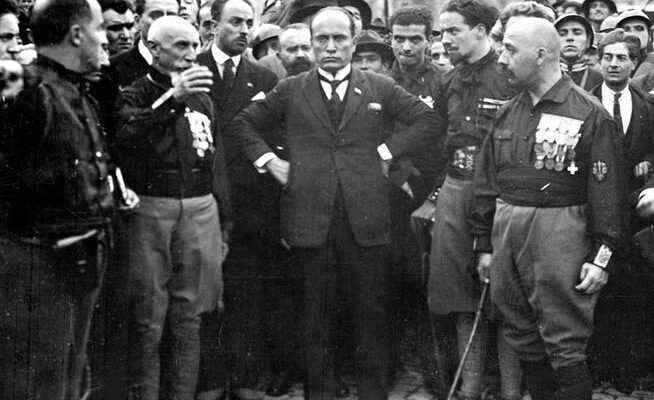Shortly before the centenary of Benito Mussolini’s “March on Rome”, post-fascist forces are about to win the elections in Italy. Circumstances have changed, but politics has remained unstable.
Benito Mussolini in a photo from autumn 1922 when he took power after the “March on Rome”.
With the “March on Rome” at the end of October 1922, the dictator Benito Mussolini seized power in Italy. Twenty years of fascist rule followed, which ended in war and civil war. A hundred years later, a victory for right-wing extremist forces is emerging in Italy in the elections at the end of September. These describe themselves as “conservative”, but clearly show post-fascist tendencies. How dangerous are Giorgia Meloni and Matteo Salvini? Is there even a risk of a new fall into fascism?
The revolutionary leader drives in a sleeper car
The “March on Rome” was a mixture of a coup d’état and a regular change of government. On October 28, 1922, fascist troops headed for the capital, about 20,000 men, there are also much higher estimates. They were poorly armed, underfed, and soaked from the rain. The law enforcement officers could have stopped and turned them back, but they received no order to do so. It was negotiated. Finally, King Vittorio Emanuele III. the fascist boss Mussolini the government order.
Mussolini had watched the “march” from Milan from a safe distance. Now he drove to Rome in a sleeping car, and on October 30 he took over the leadership of the government. The following day his blackshirts entered the capital in triumph. At the end of November, Mussolini had himself endowed with comprehensive powers (pieni poteri). Parliament eliminated itself, with the fascists holding only 35 out of 535 seats.
Lega boss Matteo Salvini demands “pieni poteri”, statements from August 2019.
Dissemble and confuse
Matteo Salvini, Leader of the Lega party, wanted to take over Italy’s government in the summer of 2019. Previously he had already ranted about a “walk to Rome”, now he demanded “pieni poteri”. He also showed himself in swimming trunks on the beach, a strong man with broad shoulders, one for the selfie. Once upon a time, the shirtless “Duce” helped with the grain harvest – someone who lent a hand. Compared to the original, the imitator becomes a caricature.
Giorgia Meloni doesn’t have to peddle Mussolini quotes, she invents her slogans herself. The most important one: “Io sono Giorgia.” A lot of things revolve around her own axis with this ice princess, who is sometimes screaming and sometimes purring. Her thick autobiography tells of exaggerated self-confidence and self-love, also of self-reflection. She is a master of dissimulation and confusion. She presents herself as a defender of “identity” and “freedom”. But she has little regard for civil liberties. She actually wants a police state of “illiberal” character. A little bit Torture belongs to them.
“Io sono Giorgia!”: Meloni talks about “identity” in October 2019.
Displeasure in a wealthy country
A hundred years ago, conditions in Italy were fundamentally different than they are today. The country was exhausted by the First World War, and large parts of the population lived in oppressive poverty. There were uprisings, strikes, factory and land occupations. Industrialists and big landowners sent thugs to protect their property and prevent a Soviet-style revolution. The “squadristi” – many of them unemployed veterans who had returned from the war – became the core of the fascist movement. Constantly changing liberal governments allowed them to do so.
There is no such thing as mass poverty today, Italy is a prosperous country. There are no starving uprisings, no revolutionary mood, no armed militias, (almost) no political violence. However, there is a diffuse dissatisfaction, some members of the lower and middle classes have existential fears. First of all, the corona pandemic caused a significant loss of income for many, and also gave rise to all sorts of fears and conspiracy theories. Inflation is now threatening a new loss of purchasing power.
Social rifts and political confrontation are likely to increase in Italy. But the country should be able to deal with it, after all it has been a functioning democracy with a lively culture of discussion for a good seventy years – and this is currently despite the mafia, Berlusconi television and the fake news epidemic or, earlier, left-wing and right-wing terrorism.
Italy’s institutions are fragile
However, key political bodies are in a permanent crisis, just like they were a hundred years ago. Parliament does not fulfill its function, important laws are generally not passed or remain piecemeal. The parties are unable to commit themselves to legislative goals. The government has just been promoted from office. The judiciary does not manage to adjudicate quickly, its supervisory bodies dismantle themselves. Such grievances play into the hands of forces that promise to create “order”, whatever.
